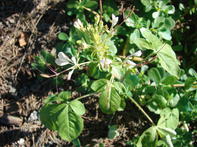Also known as cat’s whiskers and African cabbage, the spider plant (Cleome gynandra) leaves, tender stems and flowers are used for human consumption and is considered one of the many ‘African leafy vegetables’ - known as morogo or imifino in South Africa.

It is confirmed to be rich in minerals, vitamins and amino acids and is widely used in rural South Africa. Spider plant is also known as oorpeultjie (Afrikaans), lerotho (in Sepedi and Sesotho), murudi (in Tshivenda), rirudzu, bangala (in Xitsonga) and Ulude (in isiNdebele) and is said to have originated in tropical Africa and Southeast-Asia.
Cleome gynandra is most widely used as a leafy vegetable but its relatives Cleome monophylla and Cleome hirta (a popular garden plant) are also used occasionally. Spider plant occurs widely from Namibia to Limpopo and is considered a ‘weed’. Although not widely cultivated, it is often found in disturbed soils such as the homestead backyard.
Mostly used as a subsistence crop, it is also sold by street vendors. Spider plant is a herbaceous, upright annual plant that grows between 0,5 m and 1,5 m tall. It has a sticky hairy stem, compound leaves, long taproot and a multi-flowered flowerhead (resembling a spider in reference to its name - ‘spider plant’) with long-stemmed flowers and white to pink petals.
It is a branched plant that can become woody with age. The best eating bits are the leaves and growth tips. Research in India revealed that the spider plant possesses anti-inflammatory, free radical scavenging, anticancer and antidiabetic compounds.
It is also appreciated for its protective qualities - extracts repels aphids, thrips and the diamondback moth, a serious threat in cabbages.
How to Grow the Spider Plant
Spider plant is grown from seed and thrives in temperatures between 18℃ and 25℃. It does not like heavy clay soils, cold climates and shade. Seeds should be mixed at a ratio of 1:10 with dry soil and planted at shallow depth in rows 30 cm - 50 cm apart. Plants can be spaced 15 cm apart.
Although it can withstand drought, it grows best with regular watering - three times per week for sandy soils, but only once a week for clay soils. Water stress reduces leaf yield.
The spider plant responds well in more fertile, well-drained soil and adding nitrogen can increase yields. However, very high nitrogen applications will cause succulent stems which reduce regeneration.
When applying fresh poultry or pig manure, use a 10-liter bucket on an area of about 20 cm wide and 15 m long. Use the same amount of cow manure over a length of 5 m.
Always mix the manure into the soil, water and wait 14 days before planting. Spider plant is vulnerable to weed competition and pests such as snails, nematodes and insects, but its most important enemies are beetles and hurricane bugs, also known as Bagrada or painted bugs. Plant garlic, onion or parsley near spider plant to reduce infestations.
Encourage natural enemies: the eggs of Bagrada bugs are eaten by tiny wasps. A mixture of chilli, soap, garlic and paraffin has been found effective against Bagrada bugs as it helps to wash off young bugs. Spider plant is pollinated by flying insects and ants.
Leaf harvesting starts four to six weeks after germination and is harvested in summer during the first rains, until autumn. Leaves can also be picked when the plants are about 15 cm high. Leaves are eaten fresh, but can also be boiled and served like spinach.